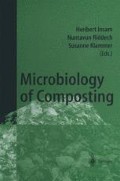Abstract
In recent investigations in 66 out of 143 tested samples of biocompost or substrates containing biocompost Clostridium botulinum was detetcted.
In commercial potting soils, containing 50% biocompost, even at the purchase day, botulinum toxin was found in the plastic bags.
Obviously,
-
the number of cases of botulism in animals has been constantly increasing in the past years;
-
demands for quality control of human food make it necessary to reduce any contamination of the soil;
-
physicians need to become aware of the importance of human botulism.
The pathogen Clostridium botulinum endangers health and life of man and animals by production of a very potent metabolite, the Botulinum Neurotoxin (BoNT). It is an anaerobic bacterium, ie., it multiplies and forms toxin under exclusion of oxygen. Under certain conditions it is even able to create its own anaerobic micro-environment in aerobic atmosphere, supporting multiplication. Clostridia are sporeformers, ie., they may survive adverse conditions very well. By the so-called hygienisation during composting possibly not all spores are destroyed. As a result surviving spores will multiply during subsequent curing and storage in compost. The nutrients, warmer temperatures, humidity, and exclusion from air form ideal growing conditions.
The different influence factors will be discussed. The laboratory proof of bacteria and toxins is complicated due to the fact that internationally only the mouse bio-assay for food and pathological samples is accepted which takes at least 5–10 days for completion. New field and laboratory tests for compost and soils were established. First results are presented.
Access this chapter
Tax calculation will be finalised at checkout
Purchases are for personal use only
Preview
Unable to display preview. Download preview PDF.
References
Baird-Parker AC., Freame B (1967) Combined effect of water activity, pH and temperature on the growth of Clostridium botulinum from spore and vegetative cell inocula. J Appl Bacteriol 30: 420 - 429
Behrens S., Sukop U, Saternus K-S, Böhnel H (1998) SID and botulism: can a correlation be proved? Res Leg Med 18: 121 - 126
Böhnel H (1988) The toxins of Clostridia (in German). J Vet Med B 35: 29 - 47
Böhnel H (1999) Botulism — a forgotten diasease? (in German) Berl Winch Tierärztl Wochenschr 112: 139 - 145
Böhnel H, Lube K (2000) Clostridium botulinum and bio-compost. A contribution to the analysis of potential health hazards caused by bio-waste recycling. J Vet Med B 47: 785-795
Böhnel H, Briese B-H, Gessler F (2000) Bio-compost and Clostridium botulinum — a health hazard for man and animals? Microbiology and Composting, Oct 2000, Innsbruck
Böhnel H, Schwagerick B, Gessler F (2001a) Visceral botulism — a new form of bovine Clostridium bolulinum toxication. J Vet Med A 48: 373 - 383
Böhnel H, Behrens S, Loch P, Lube K, Saternus K-S, Gessler F (2001b) Is there a link between infant botulism and sudden infant death? Bacteriological results obtained from central Germany. Eur J Pediatr 160: 623 - 628
Bundesgütegemeinschaft Kompost (BGK) (1994) Handbook of methods for compost analyses (in German). Abfall Now, Stuttgart
Bundesumweltministerium (1998) Bioabfallverordnung—BioAbfV BGBI 1: 2955 - 2971, Bundesdruckerei, Berlin
CDC (1998) Botulism in the United States, 1899 - 1996. Handbook for epidemiologists, cli- nicians, and laboratory workers. Center for Disease Control and Prevention, Atlanta
de Groot M, Steenhof V (1997) Composting in the European Union. DHV Environment and Infrastructure, Final report. European Commission, DG XI, Environment, nuclear safety and civil protection. Report No K 1089-61-001/AT-973090, Brussels
Deutsche Bundesstiftung Umwelt (1998) Hygiene in bio-waste composting (in German). Zeller, Osnabrück
Dolman CE (1964) Botulism as a world health problem. Environ Health Sery Food Protect 1: 5 - 32
Ewers U, Krause C, Schulz C, Wilhelm M (1999) Reference values and human biological monitoring values for environmental toxins. Int Arch Occup Environ Health 72: 255260
Grabbe M (1996) Fundamentals of bioprocess management in composting biogenic residuals and their relevance to produce compost of reproducible quality (in German). In: Wiemer K, Kern M (eds) Biological waste treatment •I (in German). M.I.C. Baeza, Witzenhausen, pp 171 - 214
Flaas CN, Rose JB, Gerba CP (1999) Quantitative microbial risk assessment. Wiley, New York
Mitscherlich E, Marth EH (1984) Microbial survival in the environment. Springer, Berlin Heidelberg New York
Popoff MR, Argente G (1996) Animal botulism, is it a menace for man? (in French) Bull Acad Vét Fr 69: 373 - 382
Seifert HSH, Böhnel H (1995) Clostridioses (in German). In: Blobel H, Schliesser T (eds) Handbook for bacterial infections in animals, vol 11/4 (in German). Fischer, Jena
Smith LD, Sugyiama H (1988) Botulism. The organism, its toxins, the disease, 2d edn. Charles C Thomas, Springfield
Westphal U (1991) Avian botulism (in German). Aula, Wiesbaden
Author information
Authors and Affiliations
Editor information
Editors and Affiliations
Rights and permissions
Copyright information
© 2002 Springer-Verlag Berlin Heidelberg
About this paper
Cite this paper
Böhnel, H., Briese, BH., Gessler, F. (2002). Methods for Health Risk Assessment by Clostridium botulinum in Biocompost. In: Insam, H., Riddech, N., Klammer, S. (eds) Microbiology of Composting. Springer, Berlin, Heidelberg. https://doi.org/10.1007/978-3-662-08724-4_43
Download citation
DOI: https://doi.org/10.1007/978-3-662-08724-4_43
Publisher Name: Springer, Berlin, Heidelberg
Print ISBN: 978-3-642-08705-9
Online ISBN: 978-3-662-08724-4
eBook Packages: Springer Book Archive

